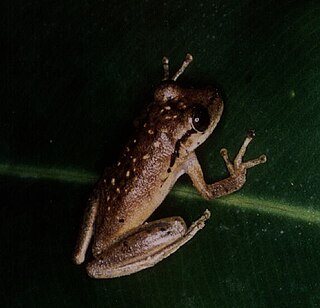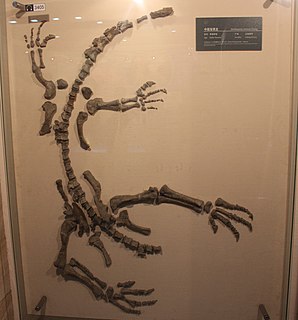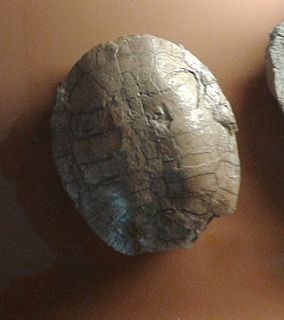Related Research Articles

Laridae is a family of seabirds in the order Charadriiformes that includes the gulls, terns and skimmers. It includes around 100 species arranged into 22 genera. They are an adaptable group of mostly aerial birds found worldwide.

Struthio is a genus of birds in the order Struthioniformes, whose members are the ostriches. It is part of the infra-class Palaeognathae, a diverse group of flightless birds also known as ratites that includes the emus, rheas, and kiwis. There are two living species of ostrich, the common ostrich and the Somali ostrich. They are large flightless birds of Africa who lay the largest eggs of any living land animal. With the ability to run at 70 km/h (43.5 mph), they are the fastest birds on land. It is farmed worldwide, particularly for its feathers as they are used as decoration and feather dusters. Its skin is also used for leather products.

Reginald Innes Pocock F.R.S. was a British zoologist.

Scinax is a genus of frogs in the family Hylidae found in eastern and southern Mexico to Argentina and Uruguay, Trinidad and Tobago, and Saint Lucia. These are small to moderate-sized tree frogs, drably colored. Duellman and Wiens resurrected this genus in 1992. The name originates from the Greek word skinos, meaning quick or nimble.
Coelurus is a genus of coelurosaurian dinosaur from the Late Jurassic period. The name means "hollow tail", referring to its hollow tail vertebrae. Although its name is linked to one of the main divisions of theropods (Coelurosauria), it has historically been poorly understood, and sometimes confused with its better-known contemporary Ornitholestes. Like many dinosaurs studied in the early years of paleontology, it has had a confusing taxonomic history, with several species being named and later transferred to other genera or abandoned. Only one species is currently recognized as valid: the type species, C. fragilis, described by Othniel Charles Marsh in 1879. It is known from one partial skeleton found in the Morrison Formation of Wyoming, United States. It was a small bipedal carnivore with elongate legs.

Gyposaurus is a genus of basal sauropodomorph dinosaur from the early Jurassic of South Africa. It is usually considered to represent juveniles of other prosauropods, but "G." sinensis is regarded as a possibly valid species.

Pelochelys is a genus of giant softshell turtles in the family Trionychidae.

Potoroo is a common name for species of Potorous, a genus of smaller marsupials. They are allied to the Macropodiformes, the suborder of kangaroo, wallaby, and other rat-kangaroo genera. All three extant species are threatened by ecological changes since the colonisation of Australia, especially the long-footed Potorous longipes (Endangered) and P. gilbertii. The broad-faced P. platyops disappeared after its first description in the nineteenth century. The main threats are predation by introduced species and habitat loss.

Eupterotidae is a family of insects in the order Lepidoptera with more than 300 described species.
Isthmomys is a genus of rodent in the family Cricetidae, belonging to the tribe Reithrodontomyini. Species are:

Elseya is a genus of large side-necked turtles, commonly known as Australian snapping turtles, in the family Chelidae. Species in the genus Elseya are found in river systems in northern and northeastern Australia and throughout the river systems of New Guinea. They are identified by the presence of alveolar ridges on the triturating surfaces of the mouth and the presence of a complex bridge strut.

Sacalia is a genus of turtles in the family Geoemydidae. The genus was erected by John Edward Gray in 1870.

Cearachelys is an extinct genus of pleurodiran turtle which existed some 80 million years ago. The genus is monotypic, with only type species Cearachelys placidoi known.

Dutuitosaurus is a genus of metoposaurids, a group of amphibians that lived during the Late Triassic period. Dutuitosaurus was discovered in the early 1960s in Morocco and is known from the lower t5 units of the Timezgadiouine Formation exposures in the Argana Basin of the High Atlas Mountains and was first described in 1976 by French paleontologist Jean-Michel Dutuit. Material of Dutuitosaurus is currently held in the Muséum national d'histoire naturelle (MNHN) in Paris, France. It was originally placed within Metoposaurus as M. ouazzoui but was subsequently placed in its own genus, Dutuitosaurus, by Hunt (1993), who identified a number of differences between Metoposaurus and the Moroccan metoposaurids. Features that differentiate Dutuitosaurus from other metoposaurids include relative elongate intercentra and a maxilla that enters the orbit.
The Myuchelys is a genus of turtles, the Australian saw-shelled turtles, in the family Chelidae and subfamily Chelodininae. They inhabit the headwaters and tributaries of rivers within their range and this led to the name Myuchelys, which is formed from the Aboriginal word myuna meaning clear water and the Greek chelys meaning turtle. They have a short neck and the intergular scute completely separates the gular scutes. They have no alveolar ridge separating them from the snapping turtles of the genus Elseya.
Nephelomys moerex is a species of rodent in the genus Nephelomys of family Cricetidae. The type locality is at Mindo in western Ecuador, where it has been recorded together with three other rodents of the oryzomyine group, Sigmodontomys aphrastus, Mindomys hammondi, and Handleyomys alfaroi, as well as three opossums, Chironectes minimus and unidentified species of Didelphis and Marmosa. Mindo is a "tiny agricultural community" located at 0°02'S, 78°48'W and 1,264 metres (4,150 ft) above sea level. It was originally described by Oldfield Thomas as a subspecies of Oryzomys albigularis. It remained synonymized under this species until it was recognized as a separate species when the genus Nephelomys was established for Oryzomys albigularis and related species in 2006.

Caponiidae is a family of ecribellate haplogyne spiders that are unusual in a number of ways. They differ from other spiders in lacking book lungs and having the posterior median spinnerets anteriorly displaced to form a transverse row with the anterior lateral spinnerets. Most species have only two eyes, which is also unusual among spiders. A few species of Caponiidae variously have four, six or eight eyes. In some species the number of eyes will increase when the spiderling changes its skin as it grows towards adulthood.
John Ernest "Jack" Randall was an American ichthyologist and a leading authority on coral reef fishes. Randall described over 800 species and authored 11 books and over 900 scientific papers and popular articles. He spent most of his career working in Hawaii. He died in April 2020 at the age of 95.
Chelonides is a genus of late Jurassic turtle from marine deposits in Lower Saxony, Germany.
References
- ↑ Lumbsch TH, Huhndorf SM. (December 2007). "Outline of Ascomycota – 2007". Myconet. Chicago, USA: The Field Museum, Department of Botany. 13: 1–58. Archived from the original on March 18, 2009.
- ↑ Hawksworth DL. (1981). "The lichenicolous Coelomycetes". Bulletin of the British Museum (Natural History). 9 (1): 1–98.